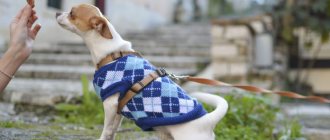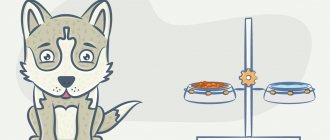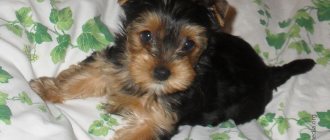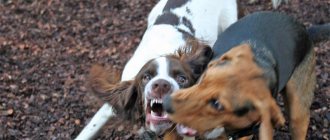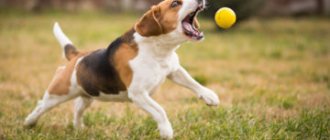Man tamed the dog a long time ago, but despite this, it still remains a predator and can demonstrate appropriate behavior. Being a pack animal, a domestic animal initially perceives a family of people as members of a pride, the head of which it considers itself. This biologically determined behavior will have to be corrected. To raise an animal adequate and obedient, it is important to know how to show your dog that you are in charge in the pack.
How to show your dog that you are in charge?
The dog's place in the family hierarchy
As a leader, the dog will only accept a person whose strength and power he will respect. It is him who he will trust and obey. At the same time, friendliness towards other family members is not excluded, but dominant manifestations are also likely. If you leave this unattended, the beast will grow uncontrollable.
A properly trained dog should know its place and occupy the last place in the hierarchy, only then will it be disciplined and obedient. To achieve this, it is important to socialize and adapt your pet from puppyhood.
The skills of correct behavior should be instilled gradually, consistently and persistently. When the dog understands what is allowed to him and what is not, he will avoid harmful habits, which would be difficult to wean an adult animal from.
The dog ranks last in the family hierarchy
Important! While admiring the furry little one, it is worth remembering that dogs, especially representatives of large and fighting breeds, feel like leaders by default, even at a tender age. If you do not correct your pet's behavior in time, the dog will grow up not just disobedient, but wayward and dangerous.
Obedience is the key to good relationships
The main task of the breeder is to set priorities and show the animal who is boss. If the dog learns the hierarchy, there will be no problems with obedience in the future. It is recommended to raise a dog up to 9 months, then it is more difficult to do it, you cannot do it without a professional.
The dog must understand from early childhood “what is good and what is bad” and be punished for any offense, otherwise the offenses will be repeated regularly. If the puppy understands and realizes that he is at the lowest level in the hierarchical ladder, it will not be difficult for him to accept the leadership of the leader.
One day, having given in some slack, the pet will go out of their control. The training process involves three stages, smoothly replacing each other:
- Studying. The puppy explores its new place of residence and neighbors, begins to understand its nickname and simple commands. The method of education is “carrot and stick”; the animal urgently needs motivation during this period.
- Correction. In addition to motivation and encouragement, the dog learns the first prohibitions and subsequent punishment for violating the rules. The breeder must observe whether such mistakes are deliberate - with the goal of dominating or accidental - due to inexperience in life.
- Abstraction. This is the period when the dog is already “programmed” for commands and familiar surroundings. It's time to change and expand your comfort zone. Take him outside more often, perform training exercises in an unusual environment, in the fresh air.
If this scheme is followed, the obedience system will be honed to the point of automaticity. The dog will learn to respond correctly not only to familiar commands, but also to the tone, gaze, and gestures of the owner. A well-mannered dog will not cause problems in the future and will become a disciplined member of the family.
Signs of Dominant Behavior
You can make sure that your pet has chosen the role of leader of the pack when he:
- demonstrates reluctance to follow commands - understands everything, but persists, observing the person’s reaction;
- shows dissatisfaction and aggression towards the owner, other family members and pets;
- snaps at attempts to take his toys, rushes and tries to take them away;
- does not allow anyone to approach the bowl or bed - he takes a fighting pose and growls threateningly;
- shows aggression towards others during walks - rushes at passing people and dogs, barks at cars and cyclists.
If you get away with such behavior, the dog feels unpunished and becomes even more convinced that it is the head of the family.
When a dog sleeps on its owners' bed, it exhibits dominant behavior.
Manifestation of “leader” traits in an animal
The so-called “leader” can be a male or female. Main qualities: high intelligence, resourcefulness, determination, willfulness, lack of fear of obstacles.
Here's how it works at home:
- They don’t give things back, but when you try to take them away they start grinning and growling.
- Aggressive towards other family members and house guests.
- They systematically violate the rules specified by the breeder.
- They try to break off the leash and do not recommend using the “Nearby” command.
- They do not respond to a nickname, although they can distinguish it perfectly by age.
- They do nasty things while looking the breeder in the eye.
- They ignore any commands from the owner.
If a person observes such behavioral errors day after day or periodically, the problem is obvious. Possible reasons include poor upbringing and individual characteristics of the breed.
How to show a puppy that the owner is more important
You should start with procedures related to care and maintenance. So, for example, while feeding a puppy, you need to add a little food into the bowl or, conversely, take some of the food out of it. The dog must recognize the owner’s right to do this and be calm about it. Another option is to feed your pet while holding the food container in your hands. So the dog will understand from an early age that the main moments of his life depend entirely on the will of the owner: as he decides, so it will be. This will allow you to avoid unnecessary manifestations of dominant behavior in the future.
Feeding a pet by hand is an element of proper upbringing
The same goes for toys. It is worth periodically trying to take your favorite item from your dog. Did you unclench your teeth and give it away? Great. The toy should be removed and returned after a while. If the dog stubbornly holds onto the item, you should not fight him, trying to take it away. You should wait for the moment when he lets go of the toy himself and take it away... forever. Exactly. When an animal shows aggression, seeing that a person is trying to take the game object left by it, you should take the pet to a cage or another room, where it will be locked for a short time. The point of such an act is for the dog to understand: in order to avoid unwanted consequences, it is better to obey.
We take the toy and return it after a while
Dog toys
Another important point is caring for the coat, eyes and teeth. This is not just hygiene measures, but also an important educational moment. You should be careful in your actions so as not to cause the dog unnecessary discomfort and pain. You should start the procedure with stroking, and then start combing the fur, cutting out tangles and other manipulations. The dog must understand that whether he likes it or not, hygiene will be carried out regardless of his desire. What and how to do is decided by the owner, so it is useless to resist. Over time, this will become commonplace, the dog will get used to it. An untrained pet will show dominant behavior every time - growl, bark, try to bite. This is fraught with injury and greatly complicates the procedure for a routine examination at a veterinary clinic.
Removing mats from a dog
How to show your older dog your leadership
This is not difficult if you systematically adhere to the following rules of conduct:
- Always enter the room first. This applies to both entering and leaving the house and moving from room to room. When the dog is nearby, he should not pass before the person. In their natural habitat, the wild ancestors of domestic dogs did exactly this: the leader went first. The same applies to behavior while walking, as well as going up and down flights of stairs. When a dog runs ahead of its owner and does not listen to his commands, it considers him to be a subordinate.
This dog clearly dominates its owner
- Do not step over the dog when it is lying on the floor and blocking the room. You should give the command for her to go to the bed, and then continue on her way. Of course, this applies to situations where there is enough space in the apartment for the animal to rest without disturbing the owners. Otherwise, you shouldn't have a pet at all.
- Do not give the animal food from the table and do not feed it before the owner and family have had dinner. The leader must eat first, this is the law.
- Show patience and fairness to your pet, but remain friendly. The leader of the pack must have a strong spirit and be honest. Dogs see this and respect it.
Patience and justice will bear fruit
- Do not allow rude behavior without a reason, do not take out a bad mood on your pet. Otherwise, the dog will grow up fearful and get used to “snarling” in response. In such a situation, it will be difficult to become a leader for the dog, much less a friend.
- Control joint games that are competitive in nature. The person should be the winner, but the dog should receive encouragement for his efforts and will to win. An owner who always wins is an excellent mentor and a good example for the animal. It is also worth remembering that the initiative to start and finish the game should always come from a person.
Two people play - the owner always wins
- Do not allow the animal to lie on sofas and beds where people sleep, or to lie on top of family members. In the understanding of the beast, moving to a higher and more comfortable territory means moving towards leadership, and lying on a person’s back or stomach is nothing more than a demonstration of one’s own superiority. In this case, the pet should be grabbed by the withers and forced to jump to the floor. After this, place it with its paws up and hold it in this position for several seconds. Some dog handlers recommend holding the dog by both cheeks at this time and looking strictly into his eyes until he looks away. In the case of large and adult dogs, this is dangerous. It’s better to just take them to a cage or place.
I hold the dog by both cheeks and look into its eyes.
- Be able to give commands correctly. It's not just about the tone in which they should be pronounced, but also about logic. A dog that has carried out an order can be misled by repeated repetition of a command phrase. That is, when the dog is sitting and it is necessary for him to remain in this position for some time, you should not repeat: “Sit!” It’s more logical to say: “Wait!” In order for the dog to understand and follow orders, the owner must be able to give them as expected. This is worth learning before you start training an animal.
Important! Be attentive and caring towards your pet. Dogs understand and really appreciate this attitude towards themselves, so they respond with love and loyalty.
The leader in the family should always remain a person
You can find out more about the methods and methods of training dogs of various breeds in a special section on our portal.
Teenage rebellion
From about 5 months of age, the dog may begin to test the boundaries of what is permitted and do things that were not previously allowed to it. Of course, ideally by this time she should already know her place in the pack, so manifestations of teenage rebellion are simply corrected by certain actions (we can say that at this age the dog needs to be constantly reminded who is boss in the house):
- The dog lies/sits in your path (especially if it is a narrow path or corridor). The leader will never bypass anyone, he walks straight, and the members of the pack must clear the way for him. Stop right in front of the pet and give the command “Place!” Wait until the path is clear (of course, if the pet is sleeping soundly, you don’t have to be so persistent).
- The dog pulls on the leash while walking. The desire to go first and drag the owner along with you is a sign of dominance. At first, a simple tug is enough. If the dog continues to pull you, suddenly change direction so that the pet has to follow you (you can change it several times, go in zigzags). This is a simple exercise that nevertheless “puts the dog in its place.”
- The dog puts his paws on you. This is a direct sign of dominance. You should not allow your dog to jump on you or put its paws on your chest. Dodge, strictly say “No!”
If a dog often puts its paws on the owner’s chest or shoulder, it is showing its dominance.
Following these guidelines will remind your teenage dog where leadership belongs.
But you shouldn’t think that the position of leader has been won once and for all. Throughout the dog's life, the owner's leadership should be reinforced by any of the exercises listed above. This is especially important for fighting dogs, guard dogs, and simply large animals that can pose a potential danger to humans. They need to not only be reminded of the boundaries of what is permitted, but educated and trained throughout their lives.
It is very important for the dog to show from the first days in the house that leadership in the pack belongs to the owner. This will help you avoid future problems with raising your pet. If you feel that you cannot cope on your own, it is better to contact an experienced dog handler in a timely manner to correct your behavior. This is especially important if you have a large watchdog or a fighting dog.
What to do if the dog is disobedient and aggressive
First, you should understand that the reason for this behavior is improper upbringing. Secondly, take steps to teach your pet good manners and respect. On the Internet you can find different opinions on this topic:
- Some concern recommendations on how to independently correct the dog’s behavior. Supposedly, if he is disobedient, but does not show excessive anger, he can fix everything on his own;
- others advise seeking help from a dog handler;
- still others believe that it is better to get rid of the “wrong” animal.
It is worth understanding that without the help of a specialist, an owner who has raised a wayward and disobedient dog is unlikely to be able to change anything. That is why the best solution would be a special training course under the guidance of an experienced instructor. Another advantage of the method is that the dog trainer will not give general recommendations, but precisely those that will help change the behavior of a particular dog. In addition, he will show in practice how to apply them.
A dog trainer will help you eliminate errors in raising your pet.
Important! As for the choice to get rid of an aggressive dog, this can only be justified by a real threat to the safety of family members. If you approach the issue in a civilized manner, it is worth choosing a new owner for the dog who is familiar with the characteristics of the breed and has the knowledge and experience to turn the animal into an adequate pet.
Clear daily routine
You need to establish a clear daily routine for your pet and follow the schedule. Dogs like to be walked and fed at the same time, they like stability. If you strictly follow your pet's daily routine, then the dog sees you as a good leader who can be relied on.
The man did not turn off the tap at night, but was surprised the next morning when he walked into the kitchen
A Russian neurologist spoke about the dangers of short naps during the day
Analysts have published an index of tourist attractiveness of Russian regions
First pet
When wanting to get a dog, many choose large breeds, citing the fact that their intelligence is higher than that of small ones. This means that the pet will understand the owner better, which means that the level of communication with the dog will be completely different. In addition, the prospect of raising not only a four-legged friend, but also a reliable protector and guard is captivating. At the same time, the mental features of some breeds are missed, which require increased attention and special behavior correction.
Dogs prone to dominant behavior are not suitable as a first pet.
If the future owner does not have experience in raising and raising dogs, it is better to purchase a companion animal as a first pet. They are less prone to dominant behavior and are not dangerous with sudden aggression.
Table 1. Dogs recommended and not recommended as a first pet.
| Dogs with a high tendency towards dominant behavior | Companion dogs |
| Caucasian Shepherd Dogs | Collie |
| Bull Terriers | Toy poodles |
| Dobermans | Labradors |
| Cane Corso | American Cocker Spaniels |
| Rottweilers | Yorkshire Terriers |
| Alabai | Golden Retrievers |
| American Bulldogs | Pomeranians |
| Pit bull terriers | Pugs |
Important! Those who definitely want to become the owner of a representative of the fighting breed should plan a special training course. It is also worth keeping in mind that representatives of working and hunting breeds should have the opportunity to realize their abilities in business; if not, they can cause a lot of unpleasant troubles to the owner.
Punishment is not a panacea
Negative reinforcement methods such as “alpha roll” (holding in a submissive position) and “skruff shakes” (shaking by the scruff of the neck) have no basis if you look closely at the behavior of wolves or dogs in a pack. Such punishment only increases fear of the owner and can cause aggression, since in this case the dog can only protect itself with its teeth. In order to achieve harmony between us and the pet, it is necessary to look at the world from the point of view of a dog, what actions on its part can entail capturing, crushing and holding an opponent? Only the desire to fight to the last to protect your life, when the main instinct is triggered - self-preservation. Therefore, do not be surprised if the pet in this situation freezes in fear, eyes bulging, or runs away squealing, or, driven into a corner, fights for its life. This behavior does not tell the dog that its owner is the leader, the “boss,” but only makes it think that the owner is a dangerous, inadequate creature from which it must either run away or defend itself. As a result, with a high degree of probability, the owner will receive rebuff from his dog in response to his aggressive behavior.


